Menu
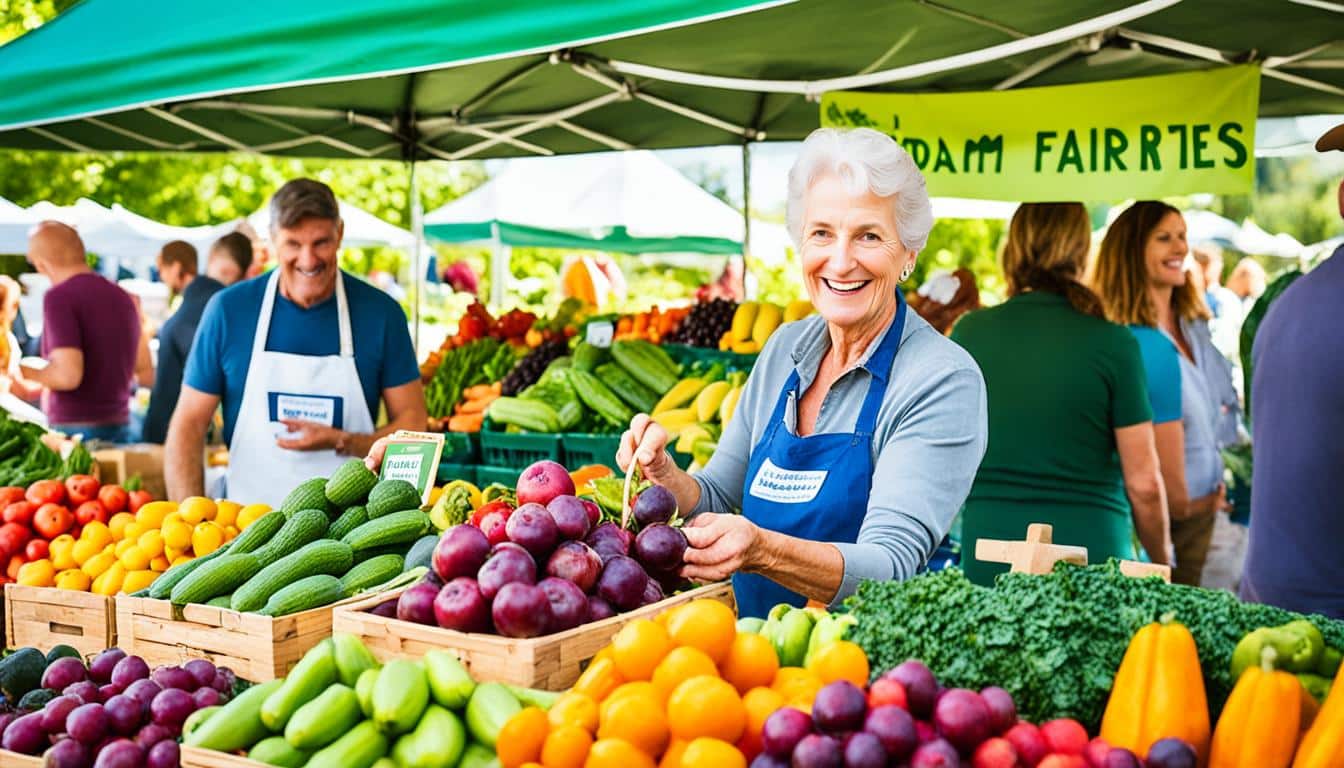
Did you know that demographics are key in promoting niche farm products? Things like age, gender, income, and where people live make a big difference. In the world of groceries, it’s vital to reach out to customers effectively. Advertising for unique farm goods is new but exciting. It helps meet the needs of those looking for special farm items. This approach aims not just to sell but to connect. By doing so, it builds strong trust and loyalty with customers.
For farm product adverts to work, using social media and partners is smart. These help marketers understand what customers like and buy. Then, they can create messages that really click with people. This boosts sales and makes the products more visible. Keeping an eye on the market and rivals is critical. It helps tweak the promotion of farm goods, keeping them up to date and attractive.
To excel in promoting a specific agricultural product, understanding your niche market is key. This starts with knowing your audience’s age, location, and interests. These aspects shape your understanding of the market.
Begin by exploring consumer segmentation to find your target audience. Look into demographic data to know who’s most interested. This tactic ensures your marketing hits the mark with the right people.
It’s crucial to know what your market prefers. Thorough market analysis uncovers buying habits and product interests. It helps to understand why certain groups choose one product over another.
For deeper insights, check out resources like the Texas AgriLife Extension Service. They teach how to segment consumers and analyse markets effectively. This knowledge makes promoting agricultural products easier and more successful.
| Niche Product | Target Audience | Key Market Insight |
|---|---|---|
| Timothy hay for race horse feed | Horse owners/trainers | Essential for dietary needs of racehorses |
| Kosher milk | Religious groups | Compliance with dietary laws |
| Organic vegetables | Health-conscious consumers | Preference for pesticide-free foods |
| Extra fat beef | Asian export market | High-demand in Asian cuisines |
| Locally grown food | Local consumers | Desire for locally sourced produce |
Keeping up with consumer preferences through market research is vital. This ensures your rural product advertising stays effective and matches what your audience wants. Learning and adjusting continuously are key to success in agricultural niche marketing.
To grab the attention of buyers, it’s key to make content that’s both interesting and connects with them. This approach is vital for making a mark digitally and strengthening ties with customers.
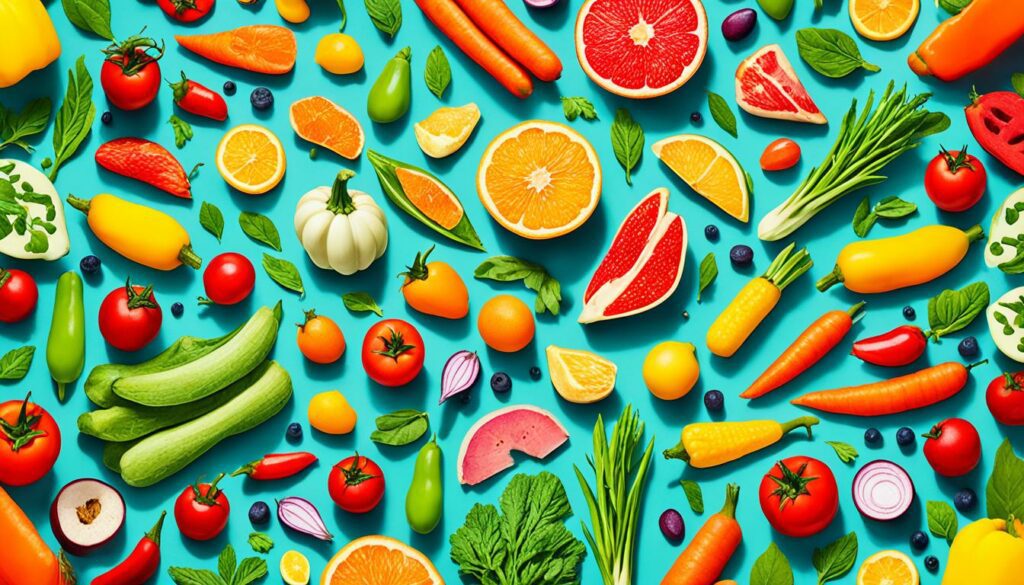
Begin by creating quality blog posts. Include recipes, farm tips, and why your products are special. This way, you can attract different kinds of people by knowing what they want to read.
Also, telling them about your farm’s way of working can make people trust you more. This is important in a busy market where everyone is trying to stand out.
Videos are a powerful tool. They can show your farm in action or how to use your products. Making these can mean investing in good equipment and software. But it’s worth it to keep up with your competition.
By showing the real story of your farm, videos can make customers trust you more. This might lead to more sales of your products.
Using social media is key for marketing special farm products. Platforms like Instagram are great for this. They help you reach young people, who often buy these products.
By using smart tags and talking to your followers, you can make a community. This builds loyalty to your brand. Plus, you can use ads to find exactly the people who would love your products.
When you mix good content with clever social media use, your unique farm products will get noticed. And that’s what you want – more people showing an interest in what you sell.
For successful agriculture marketing, using social media well is key. Plan your content, choose the right hashtags, and interact with your audience. This can boost your online and community presence a lot. Now, let’s dig into how to really make these strategies work for you.
Keeping your posts regular and on-point is crucial. Content calendars help you do that by planning ahead. This way, you post stuff that your audience really likes, from what market research finds. It keeps people engaged and lets you respond quickly to what’s hot in the market.
Hashtags play a big role in getting your posts seen in specific markets. Find and use the right ones to join important conversations. This can attract new customers interested in what you sell. For instance, using #FarmFresh or #SustainableAg can highlight your brand to the people that matter.
It’s not just about posting content; it’s about talking with your followers too. Answer their comments, messages, and reviews. This builds a strong community and customer loyalty. Plus, insights from social media platforms can show you what’s working, helping you adjust your strategies.
With social media, you can reach the right people based on what they like and what your competitors do. Use data to make smart choices and improve your marketing. For those in agriculture, specialised agencies can offer help, making things more efficient. They save time and money for farmers keen on social media.
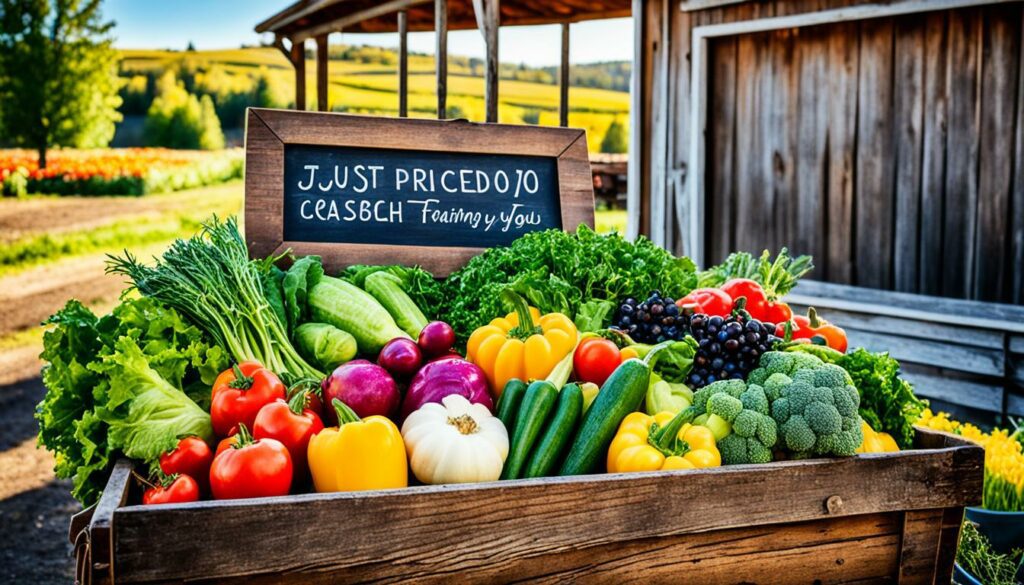
Influencers play a key role in bespoke farm items advertising. Start by choosing influencers who match your brand’s values and are trusted by their followers. With U.S. influencer marketing spending set to increase from $4.99 billion to $7.14 billion by 2024, picking the right partners is very important. They should help your brand connect well with the audience.
Picking the best influencers goes beyond their number of followers. You should consider the type of content they share and their engagement levels. Use resources like Feedspot to find influencers who are a great fit for your farm items. It’s becoming more common to work with smaller influencers because they often connect with their followers better. This was noticed by around 300 experts in marketing in 2022.
After choosing influencers, the next step is negotiating deals. Both sides need to be clear about what they expect and benefit from the deal. For example, Brand Basics works with many affiliates and paid partners monthly. Another good approach is seen with Blue Wheel Media. They offer influencers a chance to earn commissions even after the campaign ends. This makes influencer marketing a powerful tool for selling farm items.
Email marketing is a fundamental part of direct marketing strategies for farm products today. It lets farms tailor their messages to their customers. This ensures the messages are interesting and on point for each person.
Starting with a well-segmented email list is key. This means dividing it by clients’ likes, who they are, and what they buy. If your farm site sees about 30,000 visitors a month, it’s a great chance to collect emails. The aim is to talk to specific groups effectively through your tailored farm product marketing efforts.
After you’ve segmented your list, customising your communication is critical. Sending messages that address the unique interests of each group makes them more engaged. For example, sending out a series of SEO-optimised articles weekly could keep people coming back to your website. You can also use autoresponders to send timely follow-up emails and special content. These actions help to build trust and loyalty.
The four P’s of Marketing—Product, Price, Place, and Promotion—play a critical role in shaping your email campaigns. Understanding and leveraging these can make a substantial difference in your marketing results.
By focusing on email marketing and making it tailored, you can change the game in direct marketing for your farm. Offering value and engaging your audience regularly grows a loyal customer base. They’re more willing to check out and purchase your products.
Engaging with the local community is key for rural product advertising to work. By taking part in community events and forming partnerships, farmers can boost their visibility and earn the community’s trust. This direct approach helps farmers show off their goods and become part of the community.
Getting involved in local events is a great way to connect with the community. Events such as farmers’ markets and festivals let farmers display their unique products to people. These events let them meet consumers in person, creating stronger ties than just online ads can.
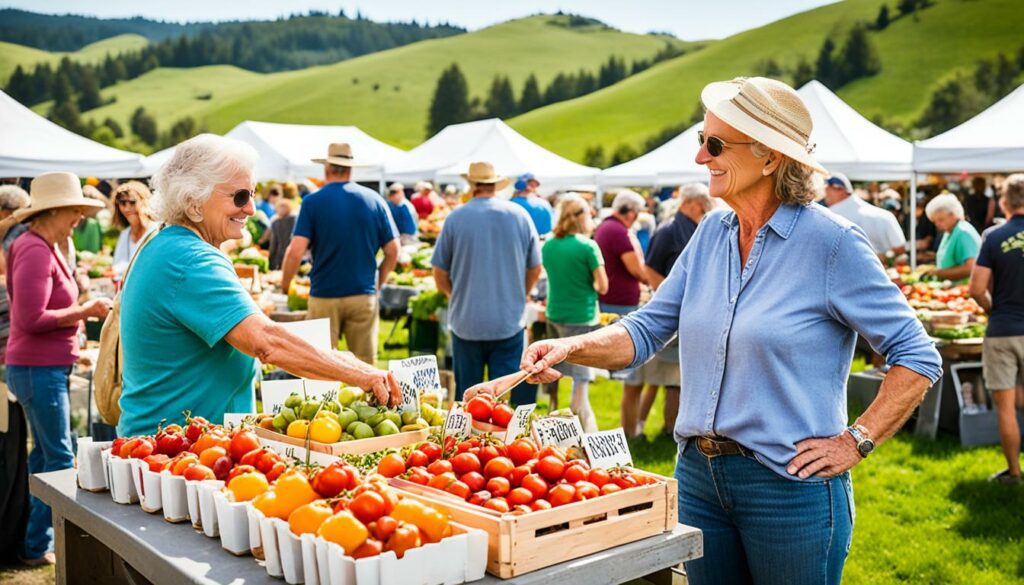
Also, the USDA’s efforts during the pandemic, offering advice through over 56 groups, set a good example. These steps helped farmers stay connected with their community, even when COVID-19 disrupted many things.
Creating partnerships within the community builds deep and lasting links. Initiatives by the FSA, like those for diverse farmers and specialty crops, show how important these connections are. The USDA’s support by providing state and regional coordinators strengthens these ties further.
Teaming up with schools, businesses, and non-profits can bring benefits to the farm and the wider community. For example, the USDA’s work with the Small Business Administration and SCORE offers farmers free business advice. This helps farmers get ahead in business while also boosting the community’s economy.
“Our partnerships with local organisations have allowed us to reach new customers and provide valuable resources to our community,” – Farmer from a USDA-supported programme.
Such partnerships help not just in advertising but also in making the community feel like they own the farm. This creates a strong system of mutual support.
In conclusion, taking part in community events and forming solid partnerships are vital for rural advertising to succeed. These friendly relationships and local engagement efforts truly make farmers a part of the communities they serve.
Using geo-targeted ads can change niche farm product advertising. It allows farms to focus on specific areas. This makes their ads reach more people who are interested. Studies have shown that these ads can make people click on them 200% more than ads without this feature.
Adding niche market focus to ads brings big gains. More than 75% of niche farm product buyers like ads showing local ingredients. This method fits well with customers wanting to know where their food comes from. It helps build trust.
These ads not only get customers interested but also help sell more products. They lead to about 12% more sales than usual ads. Plus, using this type of advertising saves money. Businesses cutting back on costs by 20% when promoting niche products.
There’s a clear edge for small farms that use these ads. They can grow their share of the market by 15%. This beats ads that aren’t focused on location. Plus, niche grocery shops have seen a 34% market boost from using these ads.
| Statistic | Value |
|---|---|
| Geo-Targeting Effectiveness | Up to 200% increase in click-through rates |
| Niche Market Interaction | 75% positive response |
| Conversion Rates | 12% average conversion |
| Cost Efficiency | 20% reduction in marketing expenditures |
| Competitive Advantage | 15% increase in market share |
| Market Share Growth | 34% increase |
Platforms like Google Ads and Facebook are great for this type of advertising. On Facebook, you can aim ads at about 60 million Americans who are interested in farming. Or, you can target about 34,000 who are farm managers. This means your money is more likely to be well spent. You can also change your budget depending on which ads are doing best. This helps you spend your money where it works the hardest.
Ads like these also help build strong links with customers. About 93% of niche grocery shops say they’ve seen big improvements by getting involved in community events. Using these ads can help build trust and keep customers loyal.
To promote specialised farm goods, a diverse content strategy works best. It connects with your audience and lets you show off unique items. It also shares interesting stories about your farm’s activities.
Good blog posts are key for promoting specialised farm goods. They let you talk about green farming, seasonal news, and the benefits of your crops. These posts help you make better high-quality content. They also make your farm more visible online, bringing in more visitors.
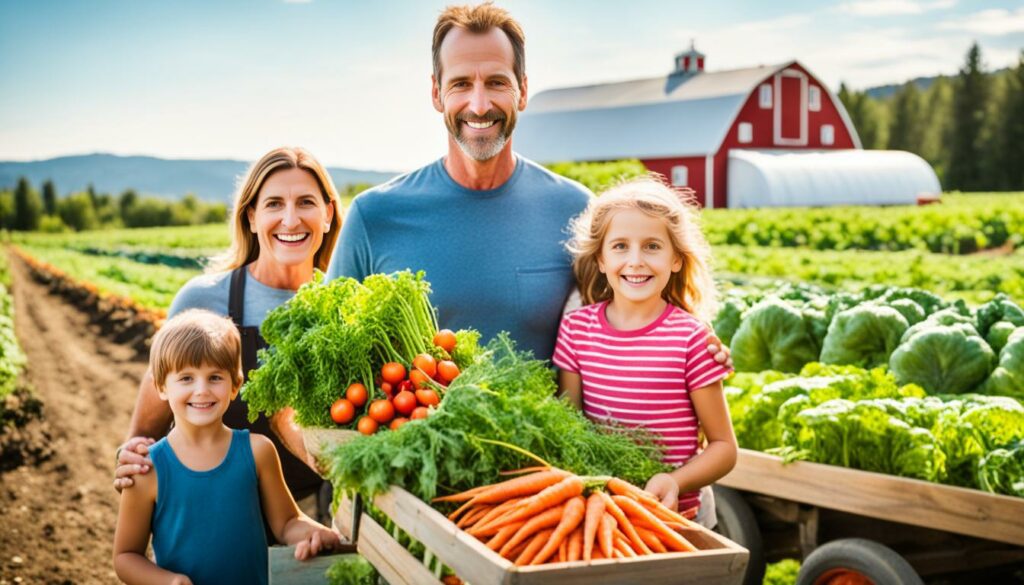
Videos are great for getting people interested. Making top-notch videos about your farm’s day-to-day can really boost your story. Videos that show your harvest, care for animals, or life on the farm draw in viewers. This not only grows brand recognition but also builds trust.
Podcasts are a new and personal way to talk about your farm products. They help listeners learn and feel a connection with your farm. This is a special way to create high-quality content and make your brand stand out. It encourages people to keep listening, making them loyal fans.
Digital marketing, especially content marketing, has a big impact on farming. Things like SEO and video marketing can boost your presence online and bring in more visitors. Email marketing is great for finding new customers too.
| Marketing Strategy | Impact |
|---|---|
| PPC Ads | 81% increase in brand awareness |
| Email Marketing | $44 return for every $1 spent, 40 times more effective than social media |
| SEO Strategies | Improved rankings and increased website traffic |
| Video Marketing | Increased user engagement and brand recognition |
Using blogs, videos, and podcasts can help spread the word about your farm products. This way, you get people interested and keep them coming back. This mix of media ensures your goods are noticed and valued properly.
Understanding customers in agriculture is key. By making buyer personas, we can make marketing that really speaks to each group. Let’s look at how to make these personas well.
Market surveys are the first big step. They help us talk directly to buyers and find out what they like. Through these surveys, we focus on learning about who they are, what they buy, and what they want from us.
After the surveys, we dive into the data. Strong analysis shows us important customer groups and how they buy. This tells us who to focus on and how to build better marketing. It also helps us make smarter choices when selling products and planning events.
By using both surveys and data analysis, our marketing meets every customer’s needs. This kind of focusing brings more customers in and keeps them loyal to our brand.
The goal of customer referral programs is simple. It’s about growing the market naturally. That’s by getting people to talk about farm products they love. In the niche farming world, a good rewards system is key. It makes current customers want to tell their friends. This way, you grow by trusted recommendations.
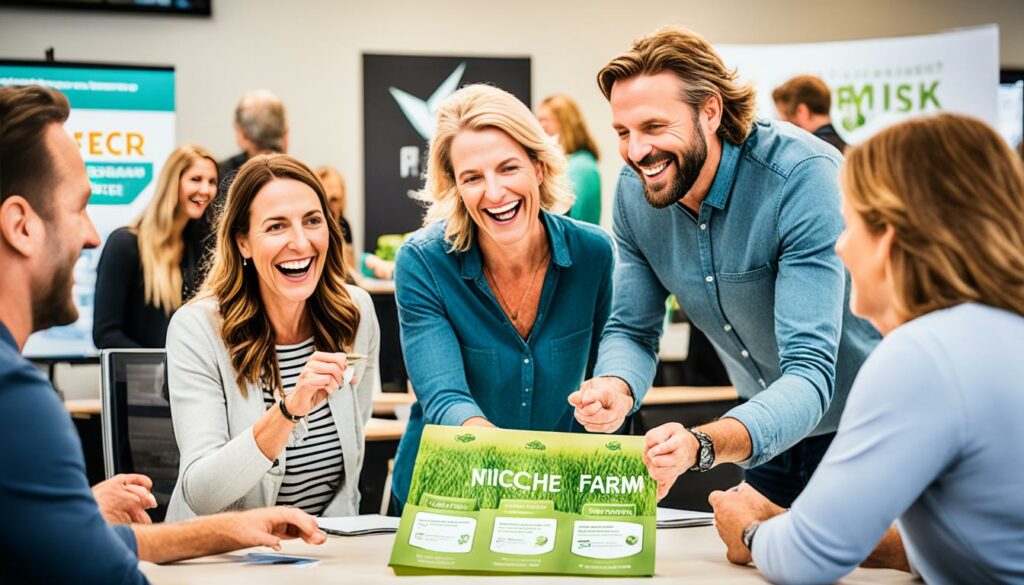
Start by knowing what your customers will like. Rewards can be anything from discounts to special farm tours. Big names in the business show that big rewards work. For example, Bee Built gives a 15% commission for selling their products. This proves high rewards can motivate people to join in.
Our farm sees big benefits from these schemes. They help us get new customers and keep the ones we have. Companies like Chelsea Green Publishing offer 15% on book sales. This makes sharing about us a great deal for anyone. Tailoring rewards can bring new leads regularly, helping us grow steadily.
Getting people to recommend our farm matters a lot. 92% of folks trust advice from their friends. It’s like free, trustworthy advertising. It also leads to more sales and related purchases. Encouraging these shares allows us to reach more people in a reliable and effective way.
Referral schemes cut down on how much new customers cost. They show where our leads come from and what people like. Using tech to track this is smart. It can lead to keeping customers happy and making more money. Ace Hardware’s big range of 323 items in one category is a great example. It shows how varied rewards can catch anyone’s eye.
Get these strategies right, and your farm can blossom. It’s not just about growing. It also boosts community and customer happiness. The trick is picking rewards that people really find valuable. This way, you build a strong, mutually supporting link between the farm and its fans.
Working with other businesses can make our niche farm items more visible. We can join forces with companies that offer things that go well with ours. This helps us show our products to fresh sets of eyes. It is especially powerful when both companies have things in common. This way, we reach more people and build a bigger market together.
Visual Objects found that lots of shoppers like products from two brands. This shows teaming up can make us more known and catch people’s interest. Co-branding comes in different forms, like when two firms team up on a project. Or they can each promote what the other does best. Both approaches can make a big splash and help their products get better over time.
Here is a table to show the good and not-so-good parts of working together on brands:
| Advantages | Challenges |
|---|---|
| Expanded Market Reach | Brand Dilution |
| Leverage Strengths | Legal Issues |
| Cost Savings | Control and Decision-Making Conflicts |
| Enhanced Brand Credibility | Cannibalisation |
| Visibility in New Niches | Reputation Damage |
It’s vital to know what our customers look for online before we team up with another business. Using the right words to talk about our farm is key. Also, our story has to match our partners’. This way, we speak the same language to our customers. Teamwork with the right businesses not only helps us beat the competition but also keeps our old customers happy. It all works to keep our brand strong and steady.
Joining hands with partners in the right way can do more than just getting our name out there. It opens doors to customers we’ve not met yet. Sharing the stage with trustworthy brands makes us look good too. This means a better shopping experience for our customers and better use of our money and ways to get our name out.
Changing from big, splashy ways to draw many people to creating a close network of farm fans can bring big gains. For small farm businesses, using referral methods is key. It helps keep customers coming back and inviting more friends.
Setting up a defined referral plan is a major step. We offer rewards to those who bring us new customers. This could be discounts on future buys or special treats. It makes our existing customers happy and turns them into our brand’s cheerleaders.
Keeping track of who is spreading the word about our farm is crucial. We reward those helping us grow. We track this with codes or special links. This makes sure our thank yous reach the right people.
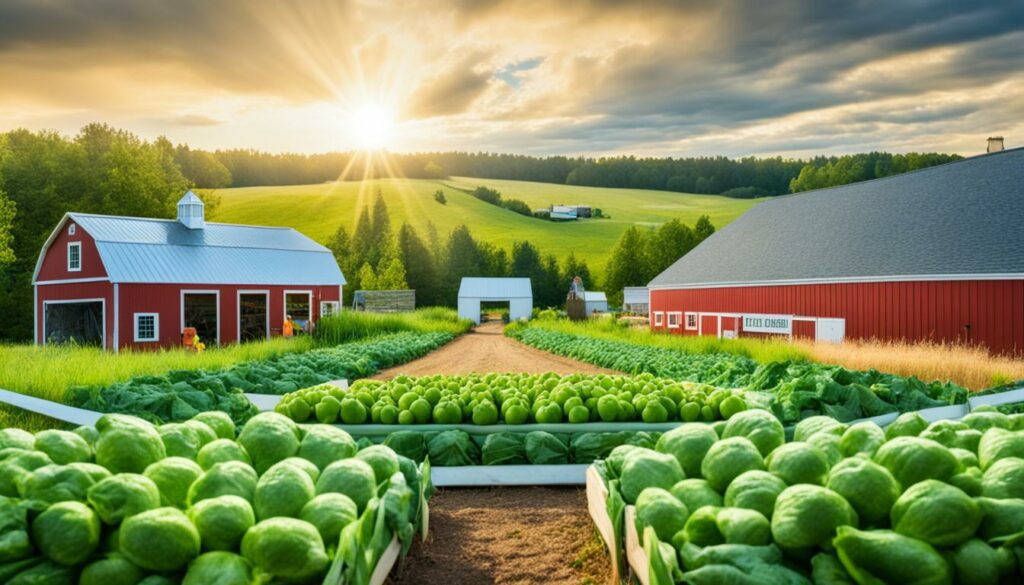
Farm items like bumper stickers and window clings are low-cost but great for getting noticed. Encouraging people to use these items spreads our name far and wide. Clothing with our brand also acts as a daily ‘thank you’ and a way to share our story.
Free press and events can do more than ads in papers. They help us meet real people who then become our fans. This leads to more people hearing about us. These events make our farm a ‘must-visit’ spot.
Below is a detailed comparison highlighting the effectiveness of various promotional strategies and their costs:
| Strategy | Cost | Effectiveness |
|---|---|---|
| Bumper Stickers | $6 each | High |
| Removable Window Clings | $8 each | High |
| Farm T-Shirts | Variable | Medium to High |
| Local Newspaper Articles | Variable | Very High |
| Paid Advertisements | Variable | Medium |
Blending referral marketing with real items and getting the word out through various channels keeps our farm business growing and our fans coming back.
Networking in agriculture boosts your profile and builds useful relationships. Joining in *agricultural industry networking* helps people swap ideas, know about the newest things, and find chances to work together. This can push the farming world ahead.
Being part of trade shows is key for success. These events let farmers and sellers show off their items, talk about what’s new, and make professional friendships. They can make your brand more well-known and connect you with interested buyers and top folks in the field.
An exciting part of *trade show participation* is seeing how the market responds to your goods and getting quick views on them. There are also talks and learning sessions that help you get what’s hot and new, supporting *industry collaboration*.
Joining agricultural groups can open many doors. You get to know more people and have access to things just for this industry. Being part of them means you can find specific studies, have someone speaking for you, and grow your skills.
Through *agricultural associations membership*, those in farming and selling can work together on big issues, using their combined power. Members often get discounts for events and classes. They also stay on top of the rules and the best ideas, making their businesses stronger.
| Event Type | Benefits | Examples |
|---|---|---|
| Trade Shows |
| World Ag Expo, Agri-Trade Equipment Expo |
| Association Membership |
| American Farm Bureau Federation, National Farmers Union |
To sum up, working the network by going to *trade shows* and joining *agricultural associations* can tie the industry together well. It brings lots of growing chances for everyone in the field.
Using smart content marketing strategies can make a big difference. It can get consumers more involved, which leads to more visits and sales. Sending out email newsletters and hosting webinars are two big tricks. These get people interested and connected with your business.
Email newsletters are key for keeping your audience interested. They update people on new products, farming tips, and cool stories. Good newsletters can also help gather more emails for your list. This, along with 30,000 visitors each month, means you can keep a lot of people interested.
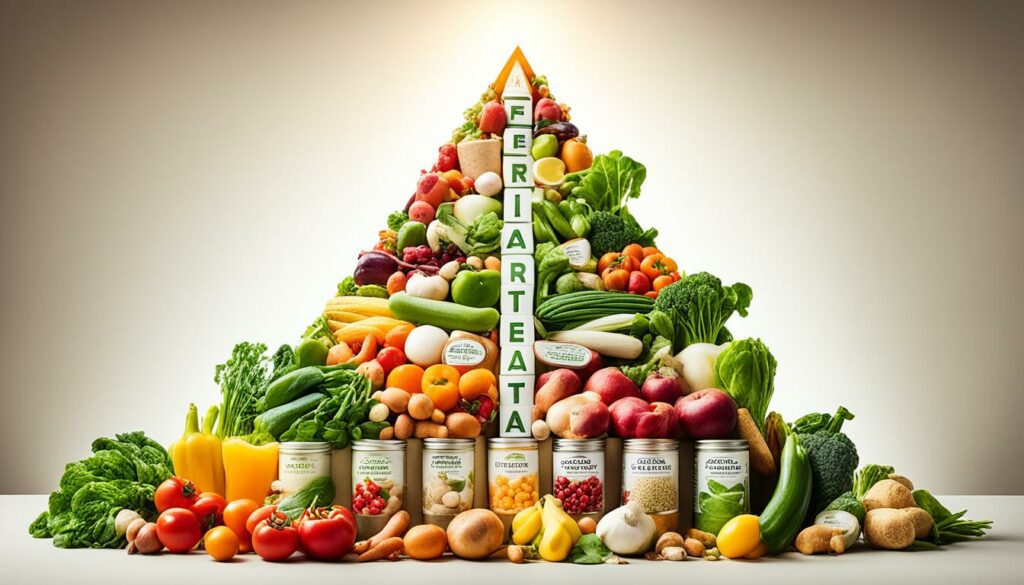
To really engage your readers, use nice images and interesting stories. Also, try to put out new content every week. Articles should be around 800-1200 words. This keeps people reading and wanting more.
Webinars are great for connecting with people in a lively way. They offer insights on your products and ways to be more eco-friendly. By hosting these, you show that you’re an expert in your field. This can win over new customers.
Marketing your webinar through SEO is key. This ensures current and new customers hear about it. An approach that uses both emails and webinars helps grow your online presence. It also broadens the market you reach.
In the world of advertising niche farm products, a broad strategy is crucial for success. Knowing how consumers behave is the first step. For example, Onozaka et al. (2010) and Nurse Rainbolt et al. (2012) talk about why studying local food buyers is key. This learning helps create focused marketing plans.
Marketing well requires a mix of methods to reach small groups of people. This mix includes writing interesting blog posts, using social media, or working with influencers. Each way helps build a strong marketing plan. It makes sure farm products’ special qualities are well known, making customers feel more connected.
Looking closely at the market and knowing how to grow is vital, according to Archer et al. (2008). Farms can stand out by being experts in certain production methods or growing organic. Lambkin and Day (1989) and Hamlin et al. (2012) found focusing on these unique points can increase sales. A good advertising plan focuses on these aspects, aiming to keep customers happy and stay successful in the market.
Niche farm product advertising targets specific consumers who are interested in unique farm produce. It aims to link the farm’s products with what these consumers like.
First, learn about your audience’s age, where they are, what they like, and how they buy products. This is done by looking at the market closely and breaking down the consumers into groups.
The best way is to really get to know what your audience likes and how they interact with your products. This knowledge helps customise your approach in promoting your farm products.
You can write interesting blog posts, make informative videos, and use social media to advertise. This method helps create a strong and recognisable digital brand.
Good tactics include using a content calendar for planning, employing the right hashtags, and regularly interacting with your followers. This boosts your content quality and keeps your audience interested.
Working with influencers who share your values can bring real support and attention to your farm products. This method is great for reaching specific audiences.
Tailoring emails to groups and personalising campaigns makes your communication more relevant. This approach improves how effectively you market your farm products to your audience.
Getting involved in local events and forming local partnerships help your farm become part of the community. Such marketing builds trust and a sense of being real among the locals.
Using ads that target specific places lets you reach the right people more effectively. Platforms such as Google Ads and Facebook Ads allow you to focus on the niche markets that are relevant to you.
Content like well-written blogs, valuable videos, and engaging podcasts tell your brand’s story well. They improve how you communicate your brand’s story online.
Create personas by asking your audience questions and analysing their habits. This type of analysis will help you target your marketing more effectively.
Key to success are rewards and encouraging customers to talk about your products. This not only grows your market but also builds customer loyalty through positive recommendations.
By partnering with similar but non-competing businesses, you can broaden your reach. This tactic increases your product’s visibility without directly competing.
Begin by setting up a system to track and reward referrals. This encourages your customers to spread the word among their friends and family.
Being present at trade shows and joining associations can help you make important connections. This way, you keep up with industry trends and find new opportunities.
Sending regular email newsletters and hosting webinars are great for keeping people interested and informed. It also positions your brand as a knowledgeable and trusted source in the industry.